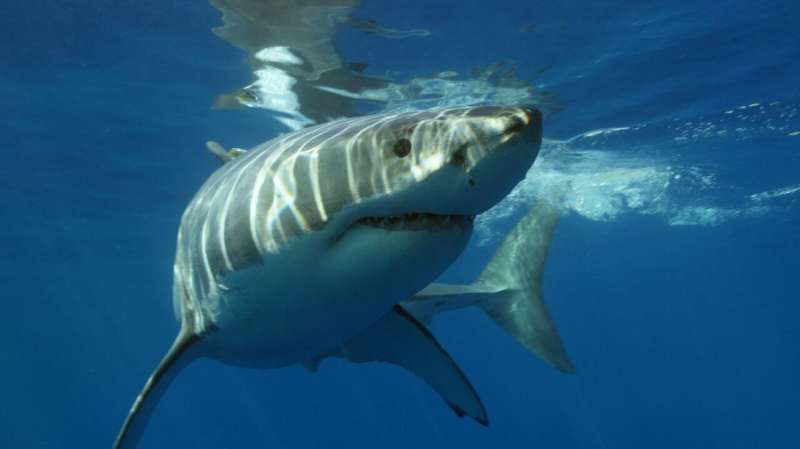This article has been reviewed according to Science X's editorial process and policies. Editors have highlighted the following attributes while ensuring the content's credibility:
fact-checked
trusted source
proofread
What we could learn from first reported footage of a newborn great white shark

It has been reported that a newborn great white shark was spotted off the southern coast of California—the first time one has been seen in the wild, experts believe.
The discovery of a newborn great white holds immense importance for scientific research, offering valuable insights into the early life stages, behavior, and ecological dynamics of this enigmatic and iconic species.
The proposed findings from Carlos Gauna and Phil Sternes could be the start of a key contribution to our understanding of the elusive reproductive cycle and aid the fight for shark conservation, and broader biodiversity considerations.
While the authors remain cautious in their approach, sharks this small in areas that have been described near nursery grounds and in areas where larger female sharks exist as sexually mature may be the first part of helping to solve the puzzle.
Shark scientists are right to question why there is an individual when it is thought great whites pup several young in the region of eight to 12, but we all know that not all offspring do as they are told and it could be that this individual has strayed off course.
It could also be possible that the mother may have moved on during the birthing process, and the pup being caught in a current losing contact with other pups in the vast deep blue, but this is another part of the reproductive cycle that remains unknown to scientists.
Studying the early life stages of great white sharks will provide crucial information about their reproductive biology. Understanding where and when these sharks give birth, as well as the size and number of offspring, will help scientists comprehend the species' reproductive strategies and therefore aid the greater protection of these endangered animals.
Gaining an insight into this stage of the lifecycle will provide knowledge that is essential for developing effective conservation measures and ensuring the long-term survival of great white shark populations.
Newborn great white sharks can offer valuable insights into their growth patterns and development. By examining their size, weight, and physical characteristics, researchers can estimate growth rates and better understand how environmental factors influence their development from a very young age.
There is already a lot of research that has taken place over several decades into environmental factors affecting different stages of the lives of great whites, as well as feeding preferences and behavioral patterns, however, this information is essential for further adding to the modeling of population dynamics and predicting how these sharks may respond to changes in their habitats, such as temperature variations or alterations in prey availability.
The potential discovery of a newborn great white shark opens up the opportunity for scientists to get funding for the ability to investigate the early behaviors and movements of these creatures. It will also hopefully enable the theories around nursery areas to be proven and further research into the movement of perceived pregnant individuals by being funded appropriately in the area.
Tracking the movements of newborn sharks will help identify the movement of them to the critical nursery areas and understand the migratory patterns of different populations on a wider scale.
This discovery is crucial for implementing effective conservation strategies in the area, as it allows the scientists to target these areas and increase the search for the benefit of understanding what is essential for the survival and well-being of young sharks.
The new publication of the perceived newborn great white shark could provide much-needed further research into the insights of their ecological role within marine ecosystems. Environmental factors, species composition, and substrate composition would lead to the understanding of newborn feeding habits and prey preferences of young sharks as opposed to the documented evidence for young of year (YOY) and juvenile sharks. It will help scientists assess their impact on prey populations and maintain a balanced ecosystem.
This information is particularly important as great white sharks are apex predators, playing a crucial role in regulating the health of marine ecosystems.
It is too early at this stage but the discovery of further newborn great white sharks and the permits associated with them may also contribute to our knowledge of the species' genetic diversity. Given the opportunity to carry out further research in the area and having the ability to analyze the genetic makeup of newborn and juvenile sharks in the area will help researchers assess the genetic composition and variation within populations across the globe.
Once again this information is vital for effective conservation management, as well as maintaining genetic diversity which is crucial for the long-term adaptability and resilience of a species in the face of environmental changes and devasting impacts that man has put upon them.
Provided by Nottingham Trent University




















